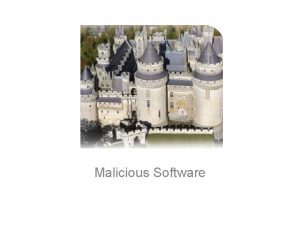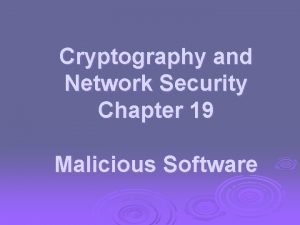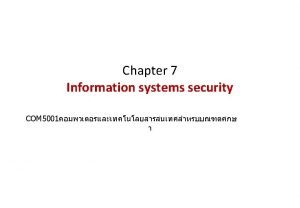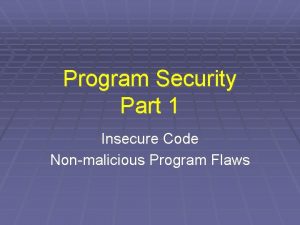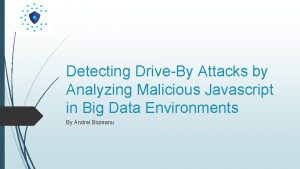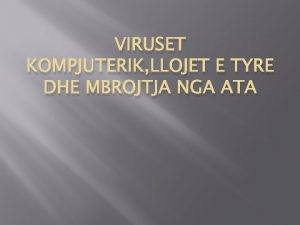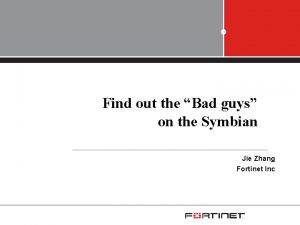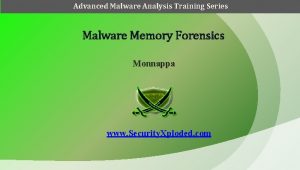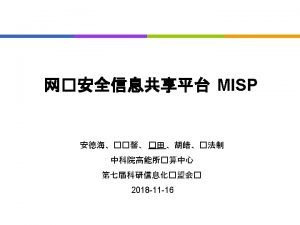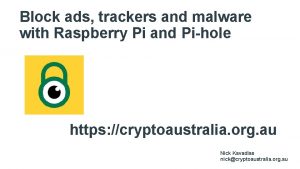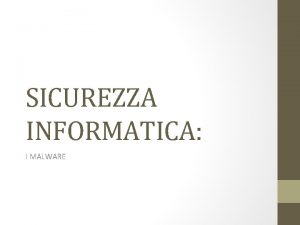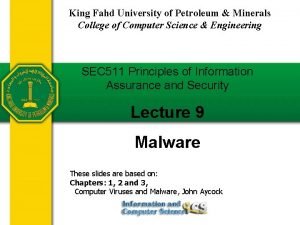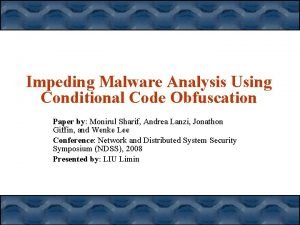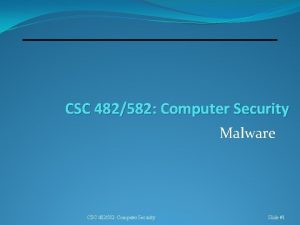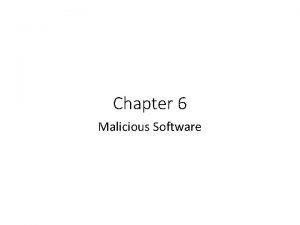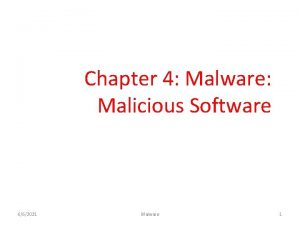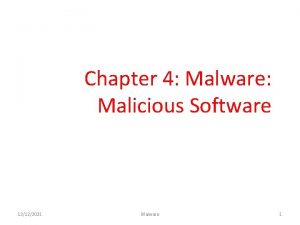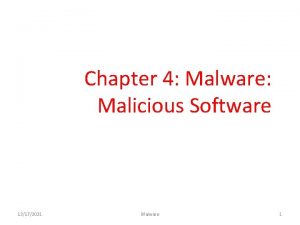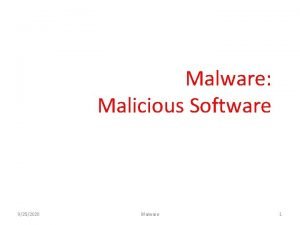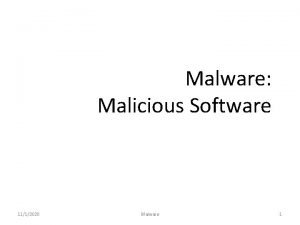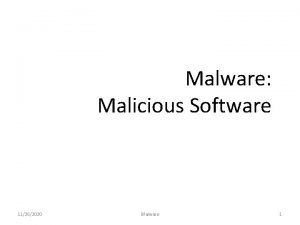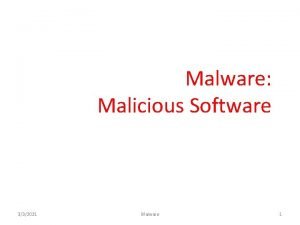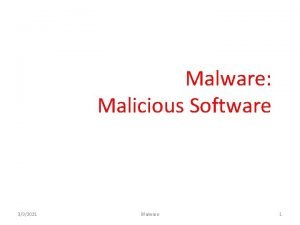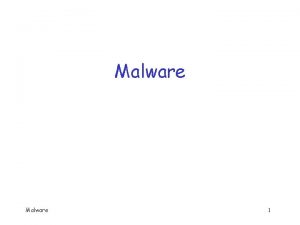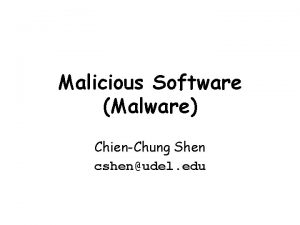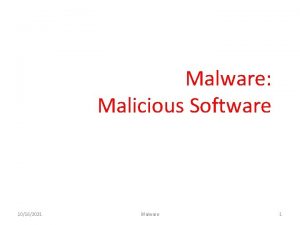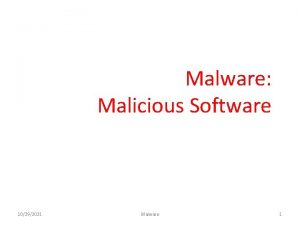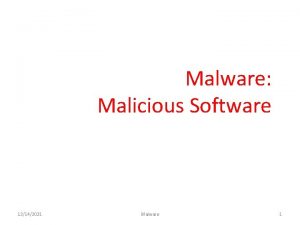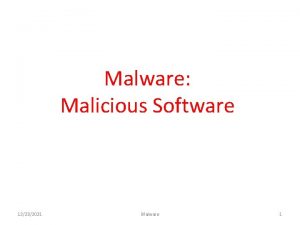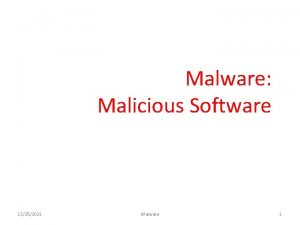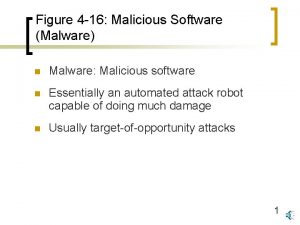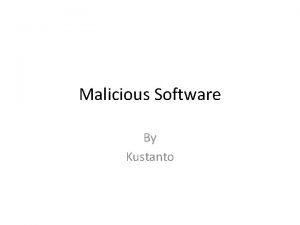Chapter 6 Malicious Software Malware SOUP 13 defines

![Malware [SOUP 13] defines malware as: “a program that is inserted into a system, Malware [SOUP 13] defines malware as: “a program that is inserted into a system,](https://slidetodoc.com/presentation_image/5dafc15a0fa94fb92dcc9fe39a128da2/image-2.jpg)





























- Slides: 31

Chapter 6 Malicious Software
![Malware SOUP 13 defines malware as a program that is inserted into a system Malware [SOUP 13] defines malware as: “a program that is inserted into a system,](https://slidetodoc.com/presentation_image/5dafc15a0fa94fb92dcc9fe39a128da2/image-2.jpg)
Malware [SOUP 13] defines malware as: “a program that is inserted into a system, usually covertly, with the intent of compromising the confidentiality, integrity, or availability of the victim’s data, applications, or operating system or otherwise annoying or disrupting the victim. ”

Classification of Malware Classified into two broad categories: Also classified by: Based first on how it spreads or propagates to reach the desired targets Those that need a host program (parasitic code such as viruses) Then on the actions or payloads it performs once a target is reached Those that are independent, self-contained programs (worms, trojans, and bots) Malware that does not replicate (trojans and spam e-mail) Malware that does replicate (viruses and worms)

Types of Malicious Software (Malware) Propagation mechanisms include: • Infection of existing content by viruses that is subsequently spread to other systems • Exploit of software vulnerabilities by worms or drive-bydownloads to allow the malware to replicate • Social engineering attacks that convince users to bypass security mechanisms to install Trojans or to respond to phishing attacks Payload actions performed by malware once it reaches a target system can include: • Corruption of system or data files • Theft of service/make the system a zombie agent of attack as part of a botnet • Theft of information from the system/keylogging • Stealthing/hiding its presence on the system

Attack Kits • Initially the development and deployment of malware required considerable technical skill by software authors o The development of virus-creation toolkits in the early 1990 s and then more general attack kits in the 2000 s greatly assisted in the development and deployment of malware • Toolkits are often known as “crimeware” o Include a variety of propagation mechanisms and payload modules that even novices can deploy o Variants that can be generated by attackers using these toolkits creates a significant problem for those defending systems against them • Widely used toolkits include: o o Zeus Blackhole Sakura Phoenix

Attack Sources • Another significant malware development is the change from attackers being individuals often motivated to demonstrate their technical competence to their peers to more organized and dangerous attack sources such as: Politically motivated attackers Criminals Organized crime Organizations that sell their services to companies and nations National government agencies • This has significantly changed the resources available and motivation behind the rise of malware and has led to development of a large underground economy involving the sale of attack kits, access to compromised hosts, and to stolen information

Advanced Persistent Threats (APTs) • Well-resourced, persistent application of a wide variety of intrusion technologies and malware to selected targets (usually business or political) • Typically attributed to state-sponsored organizations and criminal enterprises • Differ from other types of attack by their careful target selection and stealthy intrusion efforts over extended periods • High profile attacks include Aurora, RSA, APT 1, and Stuxnet

APT Attacks • Aim: o Varies from theft of intellectual property or security and infrastructure related data to the physical disruption of infrastructure • Techniques used: o Social engineering o Spear-phishing email o Drive-by-downloads from selected compromised websites likely to be visited by personnel in the target organization • Intent: o To infect the target with sophisticated malware with multiple propagation mechanisms and payloads o Once they have gained initial access to systems in the target organization a further range of attack tools are used to maintain and extend their access

Viruses • Piece of software that infects programs o Modifies them to include a copy of the virus o Replicates and goes on to infect other content o Easily spread through network environments • When attached to an executable program a virus can do anything that the program is permitted to do o Executes secretly when the host program is run • Specific to operating system and hardware o Takes advantage of their details and weaknesses

Virus Structure


Virus Classification by target • Boot sector infector o Infects a master boot record or boot record and spreads when a system is booted from the disk containing the virus • File infector o Infects files that the operating system or shell considers to be executable • Macro virus o Infects files with macro or scripting code that is interpreted by an application • Multipartite virus o Infects files in multiple ways Classification by concealment strategy • Encrypted virus o A portion of the virus creates a random encryption key and encrypts the remainder of the virus • Stealth virus o A form of virus explicitly designed to hide itself from detection by anti-virus software • Polymorphic virus o A virus that mutates with every infection • Metamorphic virus o A virus that mutates and rewrites itself completely at each iteration and may change behavior as well as appearance

Worms • Program that actively seeks out more machines to infect and each infected machine serves as an automated launching pad for attacks on other machines • Exploits software vulnerabilities in client or server programs • Can use network connections to spread from system to system • Spreads through shared media (USB drives, CD, DVD data disks) • E-mail worms spread in macro or script code included in attachments and instant messenger file transfers • Upon activation the worm may replicate and propagate again • Usually carries some form of payload • First known implementation was done in Xerox Palo Alto Labs in the early 1980 s

Worm Replication Electronic mail or instant messenger facility • Worm e-mails a copy of itself to other systems • Sends itself as an attachment via an instant message service File sharing • Creates a copy of itself or infects a file as a virus on removable media Remote execution capability • Worm executes a copy of itself on another system Remote file access or transfer capability • Worm uses a remote file access or transfer service to copy itself from one system to the other Remote login capability • Worm logs onto a remote system as a user and then uses commands to copy itself from one system to the other

Mobile Code • Programs that can be shipped unchanged to a variety of platforms • Transmitted from a remote system to a local system and then executed on the local system • Often acts as a mechanism for a virus, worm, or Trojan horse • Takes advantage of vulnerabilities to perform its own exploits • Popular vehicles include Java applets, Active. X, Java. Script and VBScript

Mobile Phone Worms • • • First discovery was Cabir worm in 2004 Then Lasco and Comm. Warrior in 2005 Communicate through Bluetooth wireless connections or MMS Target is the smartphone Can completely disable the phone, delete data on the phone, or force the device to send costly messages • Comm. Warrior replicates by means of Bluetooth to other phones, sends itself as an MMS file to contacts and as an auto reply to incoming text messages

Drive-By-Downloads • Exploits browser vulnerabilities to download and installs malware on the system when the user views a Web page controlled by the attacker • In most cases does not actively propagate • Spreads when users visit the malicious Web page

Clickjacking • Vulnerability used by an attacker to • Also known as a usercollect an infected user’s clicks interface (UI) redress attack o The attacker can force the user to do a variety of things from adjusting the user’s computer setters to unwittingly • Using a similar technique, sending the user to Web sites that might keystrokes can also be have malicious code hijacked o By taking advantage of Adobe Flash or o A user can be led to believe they are typing in the password to their email or bank account, but are instead typing into an invisible frame controlled by the attacker Java. Script an attacker could even place a button under or over a legitimate button making it difficult for users to detect o A typical attack uses multiple transparent or opaque layers to trick a user into clicking on a button or link on another page when they were intending to click on the top level page o The attacker is hijacking clicks meant for one page and routing them to another page

Social Engineering • “Tricking” users to assist in the compromise of their own systems Spam Unsolicited bulk e-mail Trojan horse Mobile phone trojans Program or utility containing harmful hidden code First appeared in 2004 (Skuller) Used to accomplish functions that the attacker could not accomplish directly Target is the smartphone Significant carrier of malware Used for phishing attacks

Payload System Corruption • Real-world damage • Causes damage to physical equipment o Chernobyl virus rewrites BIOS code • Stuxnet worm o Targets specific industrial control system software • There are concerns about using sophisticated targeted malware for industrial sabotage • Logic bomb • Code embedded in the malware that is set to “explode” when certain conditions are met

Payload – Attack Agents Bots • Takes over another Internet attached computer and uses that computer to launch or manage attacks • Botnet - collection of bots capable of acting in a coordinated manner • Uses: • • • Distributed denial-of-service (DDo. S) attacks Spamming Sniffing traffic Keylogging Spreading new malware Installing advertisement add-ons and browser helper objects (BHOs) • Attacking IRC chat networks • Manipulating online polls/games

Remote Control Facility • Distinguishes a bot from a worm • Worm propagates itself and activates itself • Bot is initially controlled from some central facility • Typical means of implementing the remote control facility is on an IRC server • Bots join a specific channel on this server and treat incoming messages as commands • More recent botnets use covert communication channels via protocols such as HTTP • Distributed control mechanisms use peer-to-peer protocols to avoid a single point of failure

Payload – Information Theft Keyloggers and Spyware Keylogger • Captures keystrokes to allow attacker to monitor sensitive information • Typically uses some form of filtering mechanism that only returns information close to keywords (“login”, “password”) Spyware • Subverts the compromised machine to allow monitoring of a wide range of activity on the system • Monitoring history and content of browsing activity • Redirecting certain Web page requests to fake sites • Dynamically modifying data exchanged between the browser and certain Web sites of interest

Payload – Information Theft Phishing • Exploits social engineering to leverage the user’s trust by masquerading as communication from a trusted source • Include a URL in a spam e-mail that links to a fake Web site that mimics the login page of a banking, gaming, or similar site • Suggests that urgent action is required by the user to authenticate their account • Attacker exploits the account using the captured credentials • Spear-phishing • Recipients are carefully researched by the attacker • E-mail is crafted to specifically suit its recipient, often quoting a range of information to convince them of its authenticity

Worm Countermeasures • Considerable overlap in techniques for dealing with viruses and worms • Once a worm is resident on a machine anti-virus software can be used to detect and possibly remove it • Perimeter network activity and usage monitoring can form the basis of a worm defense • Worm defense approaches include: o Signature-based worm scan filtering o Filter-based worm containment o Payload-classification-based worm containment o Threshold random walk (TRW) scan detection o Rate limiting o Rate halting

Payload – Stealthing Backdoor • Also known as a trapdoor • Secret entry point into a program allowing the attacker to gain access and bypass the security access procedures • Maintenance hook is a backdoor used by Programmers to debug and test programs • Difficult to implement operating system controls for backdoors in applications

Payload - Stealthing Rootkit • Set of hidden programs installed on a system to maintain covert access to that system • Hides by subverting the mechanisms that monitor and report on the processes, files, and registries on a computer • Gives administrator (or root) privileges to attacker • Can add or change programs and files, monitor processes, send and receive network traffic, and get backdoor access on demand

Malware Countermeasure Approaches • Ideal solution to the threat of malware is prevention Four main elements of prevention: • Policy • Awareness • Vulnerability mitigation • Threat mitigation • If prevention fails, technical mechanisms can be used to support the following threat mitigation options: • • • Detection Identification Removal

Generic Decryption (GD) • Enables the anti-virus program to easily detect complex polymorphic viruses and other malware while maintaining fast scanning speeds • Executable files are run through a GD scanner which contains the following elements: • • • CPU emulator Virus signature scanner Emulation control module • The most difficult design issue with a GD scanner is to determine how long to run each interpretation

Host-Based Behavior-Blocking Software • Integrates with the operating system of a host computer and monitors program behavior in real time for malicious action • Blocks potentially malicious actions before they have a chance to affect the system • Blocks software in real time so it has an advantage over anti-virus detection techniques such as fingerprinting or heuristics Limitations • Because malicious code must run on the target machine before all its behaviors can be identified, it can cause harm before it has been detected and blocked

Perimeter Scanning Approaches • Anti-virus software typically included in email and Web proxy services running on an organization’s firewall and IDS • May also be included in the traffic analysis component of an IDS • May include intrusion prevention measures, blocking the flow of any suspicious traffic • Approach is limited to scanning malware Ingress monitors Egress monitors Located at the border between the enterprise network and the Internet Located at the egress point of individual LANs as well as at the border between the enterprise network and the Internet One technique is to look for incoming traffic to unused local IP addresses Monitors outgoing traffic for signs of scanning or other suspicious behavior Two types of monitoring software
 Cuckoo static analysis
Cuckoo static analysis Short for malicious software
Short for malicious software Malicious software in cryptography
Malicious software in cryptography Malicious software
Malicious software Designed to send you advertisements
Designed to send you advertisements Malicious attacks threats and vulnerabilities
Malicious attacks threats and vulnerabilities Malicious logic in information security
Malicious logic in information security Malicious logic
Malicious logic Malicious logic
Malicious logic Known malicious user-agents
Known malicious user-agents Non malicious program errors
Non malicious program errors Malicious code indications
Malicious code indications Malicious in a sentence
Malicious in a sentence Does malicious code manifest itself
Does malicious code manifest itself Abate vocabulary
Abate vocabulary Malicious javascript
Malicious javascript Viruset kompjuterike dhe llojet e tyre
Viruset kompjuterike dhe llojet e tyre Feature vectors
Feature vectors Malware radar
Malware radar Malware tabletop exercise
Malware tabletop exercise Symbian malware
Symbian malware Memory forensics training
Memory forensics training Misp book
Misp book Wat is malware
Wat is malware Best pihole blocklists
Best pihole blocklists Malware, nella sicurezza informatica indica
Malware, nella sicurezza informatica indica Malware reverse engineering training
Malware reverse engineering training Bomb cryptor
Bomb cryptor Malware analysis
Malware analysis Malware detection
Malware detection Type de malware
Type de malware Apatedns
Apatedns

